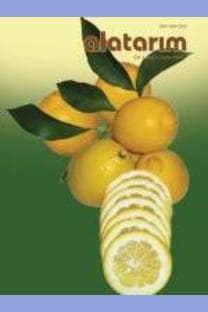Sıcak su uygulaması ve modifiye atmosferde paketlemenin Mirella $F _1$ domates çeşidinin muhafaza süresi ve kalitesi üzerine etkileri
sıcak su işlemleri, modifiye atmosfer depolaması, paketleme, depolama ömrü, depolama kalitesi, domates, çeşitler
The effects of hot water treatment and modified atmosphere packaging on storage and postharvest quality of tomato cv. Mirella $F _1$
hot water treatment, modified atmosphere storage, packaging, storage life, storage quality, tomatoes, varieties,
___
- Akbudak, B., Akbudak, N., Seniz, V., Eris, A., 2007. Sequential Treatments of Hot Water and Modified Atmosphere Packaging in Cherry Tomatoes. Journal of Food Quality, 30: 896-910.
- Ali, M.S., Nakano, K., Maezawa, S., 2004. Combined Effect of Heat Treatment and Modified Atmosphere Packaging on the Color Development of Cherry Tomato. Postharvest Biology and Technology, 34: 113–116.
- Anonim, 2008. FAO Agricultural Statistical Database. http://faostat.org.
- Batu, A., Thompson, A.K., 1998. Effects of Modified Atmosphere Packaging on Post Harvest Qualities of Pink Tomatoes. Tr. J. of Agriculture and Forestry 22: 365-372.
- Dumas, Y., Dadomo, M., Di Lucca, G., Grolier, P., 2003. Effects of Environmental Factors and Agricultural Techniques on Antioxidant Content of Tomatoes. Journal of the Science of Food and Agriculture 83:369–382.
- Fallik, E., 2004. Prestorage Hot Water Treatments (Immersion, Rinsing and Brushing). Postharvest Biology and Technology 32: 125–134.
- Fallik, E., Klein, J., Grinberg, S., Lomaniec, E., Lurie, S., Lalazar, A., 1993. Effect of Postharvest Heat Treatment of Tomatoes on Fruit Ripening and Decay Caused by Botrytis cinerea. Plant Dis., 77: 985-988.
- Javanmardi, J., Kubota, C., 2006. Variation of Lycopene, Antioxidant Activity, Total Soluble Solids and Weight Loss of Tomato during Postharvest Storage. Postharvest Biology and Technology 41:151-155.
- Kader, A.A., 2002. Postharvest Technology of Horticultural Crops. University of California Agriculture and Natural Resources, Publication 3311.
- Kasım, R., 2001. Hasat Öncesi Maleik Hidrazit ve Ethephon Uygulamalarının Havucun Muhafaza Süresine Etkisi, Doktora Tezi, Ankara Üniversitesi Fen Bilimleri Enstitüsü Bahçe Bitkileri Anabilim Dalı, Ankara, (yayınlanmamış).
- Küçükbasmacı-Sabır, F., 2008. Bütün ve Taze Doğranmış Domateslerde Farklı Derim Sonrası Uygulamaların Muhafaza Süresi ve Kalite Üzerine Etkileri, Doktora Tezi, Çukurova Üniv. Fen Bilimleri Enstitüsü Bahçe Bitkileri Anabilim Dalı, Adana, (yayınlanmamış).
- Küçükbasmacı-Sabır, F., Ağar, İ.T., 2008. Modifiye Atmosferde Muhafazanın Çengelköy Hıyar Çeşidinde Meyve Kalitesi Üzerine Etkileri, Alatarım 7(1): 29-35.
- Lu, J., Charles, M.T., Vignealt, C., Goyette, B., Raghavan, G.S.V., 2010. Effect of Heat Tretament Uniformity on Tomato Ripening and Chilling Injury, Postharvest Biology and Technology 56: 155–162.
- Lurie, S., Postharvest Heat Treatments, Postharvest Biology and Technology 14: 257–269, (1998)
- Marangoni, A.G., Stanley, D.W., 1991. Studies on the Long-Term Storage of Mature Green Tomato Fruit. Journal of Horticultural Science, 66(1): 81-84.
- McDonald, R.E., McCollum, G.T., Baldwin, E.A., 1999. Temperature of Water Heat Treatments Influences Tomato Fruit Quality Following Low-Temperature Storage. Postharvest Biology and Technology, 16: 47–155.
- McGuire, R.G., 1992. Reporting of Objective Color Measurements. HortScience, Vol. 27 (12), 1254-1255.
- Moretti, C.L., Mattos, L.M., Berg, F.L.N., Santos, J.Z., 2005. Quality Attributes of Tomatoes Submitted to Different Postharvest Treatments. Proc. 5th Int. Postharvest Symp. (Eds. F. Mencarelli and P. Tonutti), Acta Hort., 682: 1029-1035.
- Nakhasi, S., Schlimme, D., Solomos, T., 1991. Storage Potential of Tomatoes Harvested at the Breaker Stage Using Modified Atmosphere Packing. Journal of Food Science, 56 (1): 55-59.
- Nunes, M.C.N, 2008. Color Atlas of Postharvest Quality of Fruits and Vegetables. John Wiley & Sons, INC., p 239-243.
- Sandhya, 2010. Modified Atmosphere Packaging of Fresh Produce: Current Status and Future Needs. LWT - Food Science and Technology, 43: 381–392.
- Suparlan, B., Itoh, K., 2003. Combined Effects of Hot Water Treatment (HWT) and Modified Atmosphere Packaging (MAP) on Quality of Tomatoes. Packag. Technol. Sci., 16: 171- 178.
- Tano, K., Oule, M.K., Doyon, G., Lencki, R.W., Arul, J., 2007. Comparative Evaluation of the Effect of Storage Temperature Fluctuation on Modified Atmosphere Packages of Selected Fruit and Vegetables, Postharvest Biology and Technology, 46: 212-221.
- Thompson, A.K., 2001. Controlled Atmosphere Storage of Fruits and Vegetables, CAB International, 278 p.
- Thompson, A.K., 2003. Fruit and Vegetables Harvesting, Handling and Storage. Blackwell Publishing.
- Toor, R. K., Savage, G.P., Changes in Major Antioxidant Components of Tomatoes during Post-Harvest Storage, Food Chemistry 99: 724–727, (2006).
- USDA, 1991. United States Standards for Grades of Fresh Tomatoes, United States Department of Agriculture, Agricultural Marketing Service, s.13.
- Yılmaz, E., 2001. The Chemistry of Fresh Tomato Flavor, Turk J Agric For 25:149-155.
- ISSN: 1304-2653
- Yayın Aralığı: 2
- Başlangıç: 2015
- Yayıncı: Alata Bahçe Kültürleri Araştırma Enstitüsü
Topraksız kültürde çilek yetiştirme olanakları
Ferhan K. SABIR, B. Selahattin ŞENEL, İ. Tayfun AĞAR
Kadir Uğurtan YILMAZ, Oktay TANER, Mustafa ŞAHİN, Nesrin Sağlam OKUR, Bülent ÖZTÜRK, Belgin ÇELİK
Uçucu yağ sektörünün ulusal ekonomimizdeki yeri, sorunları ve çözüm önerileri
Pleurotus ostreatus yetiştiriciliğinde tarımsal artıkların verim üzerine etkisi
